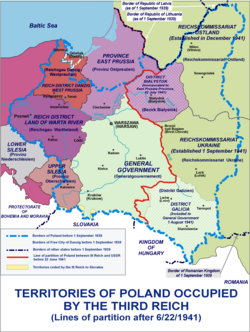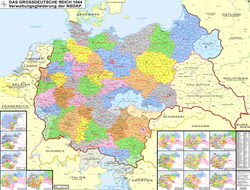Warthegau
|
Reichsgau Wartheland Warthegau |
||||||
| Reichsgau of Nazi Germany | ||||||
|
||||||
|
||||||
Map of Nazi conquest showing administrative subdivisions (Gaue and Reichsgaue) with Warthegau area (bright yellow, right).
 Reichsgau Wartheland (burgundy) on the map of occupied Second Polish Republic |
||||||
| Capital | Posen | |||||
| Gauleiter | ||||||
| • | 1939–1945 | Arthur Greiser | ||||
| History | ||||||
| • | Establishment | 2 November 1939 | ||||
| • | German surrender | 8 May 1945 | ||||
| Today part of |
|
|||||
The Reichsgau Wartheland (initially Reichsgau Posen, also: Warthegau) was a Nazi German Reichsgau formed from parts of Polish territory annexed in 1939 during World War II. It comprised the region of Greater Poland and adjacent areas. Parts of Warthegau matched the similarly named pre-Versailles Prussian province of Posen. The name was initially derived from the capital city, Posen (Poznań), and later from the main river, Warthe (Warta).
During the Partitions of Poland from 1793, the bulk of the area had been annexed by the Kingdom of Prussia until 1807 as South Prussia. From 1815 to 1849, the territory was within the autonomous Grand Duchy of Posen, which was the Province of Posen until Poland was re-established in 1918–1919 following World War I. The area is currently the Greater Poland Voivodeship.
After the invasion of Poland, the conquered territory of Greater Poland was split between four different Reichsgaue and the General Government area (further east). The Militärbezirk Posen was created in September 1939, and on 8 October 1939 annexed by Germany, as the Reichsgau Posen, with SS Obergruppenfuhrer Arthur Greiser as the only Gauleiter. The name Reichsgau Wartheland was introduced on 29 January 1940.
...
Wikipedia



